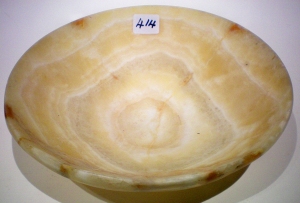I bet you’re starting to get annoyed now, aren’t you? You’ve been sitting there at the offering table for days. The waiter brought your bread and beer and then cleared off. That was days ago. Not a sniff of dinner since. There aren’t even any crumbs left – and that’s saying something for an ancient Egyptian funerary feast. You know how much they loved their bread. You’re must be almost on the point of walking out.
If you think you’ve got it bad, imagine what it must have been like for the ancient Egyptian (deceased); (what it may still be like, for all we know, if you’ve read Terry Pratchett’s Pyramids). Eternity could go by, and still no main course – to prevent which is the point of the offering formula, of course.
I am terribly sorry. You must be starving. Let’s bring on the meat.


Kau apedu, shes menkhet: meat and fowl, alabaster and clothing. Not just the main course, but the fingerbowl and napkin afterwards. How’s that for service?
Let’s take the first pair of dishes: kau apedu, meat (and) fowl. (You’ll have noticed by now that the ancient Egyptians didn’t bother much with the word “and”. In that respect, they were five millennia ahead of Google.)
Ka is the word for ox or beef, and is written with the head of an ox. Aped is the word for bird, and is written here with the head of a pintail duck. In the compressed rendition of the offering formula, they stand for any kind of meat or fowl; a limited menu is no good when you have the whole of your afterlife to fill. The –w suffix, conventionally pronounced –u, is the plural, and is normally rendered by three short strokes, which are absent in this handwritten version but present in the painted version, below:

The ox head is a tricky sign to draw, but satisfying when you master it. You can start with a roughly trapezoid outline for the shape of the head, rounding the corners and going in a bit for the bridge of the nose. Then add a u-shape on top for the horns, a little ear and a dot for the eye.
For the duck’s head, I usually start with the beak, widen out the head and give it a graceful curved neck. It may not be a swan, but it’s not an ugly duckling, either. And don’t forget to dot its eye as well.
Meat especially was a high status food, usually served only to the gods and their servants, and to the wealthy. The well endowed tomb owner expected nothing less, and expected it served on the best dinner service, too, hence the stipulation of alabaster.
The loopy-looking sign pronounced shes is indeed a loop: a loop of cord or rope, pronounced in a similar way to the word for alabaster and so used to express it in writing. But they didn’t want any ropey old dishes. They were expecting something more like this:


I don’t need to describe how to draw the loop of cord, do I? Let’s move on to the final sign, menkhet: clothing.
We’ve all seen some outlandish catwalk creations, some of them being worn in restaurants, but even so I doubt that many people would identify the menkhet sign as an item of clothing. It looks more like a child’s swing. But, you know how things look completely different when you see them through a microscope? Well, the menkhet sign is an extreme close-up of the edge of a piece of cloth. It’s the edge of a piece of cloth with a fringe, in which the individual threads are twisted together to make thicker dangly bits. The symbol shows two sets of two threads twisted together. You’d think they’d be hanging down, wouldn’t you, but they’re sticking up. They went in for subverting expectations in ancient Egyptian couture.
You can see an example of fringing in this tunic:

At least the hieroglyph is easy to draw: a straight line with two upside-down y shapes on top.
And this completes the second line of the offering formula. (Not so fast, you’re saying, what’s that extra sign under the three short strokes in the painted version? It’s a rolled-up garment of some sort, reinforcing the clothing idea of menkhet, but stuck under the food signs for the usual reason of pleasing arrangement of the signs.)
As I was saying, this completes the first two lines of the offering formula. To recap:
![]()
Well done! That was worth waiting for, wasn’t it? But I won’t blame you if you don’t leave a tip.




